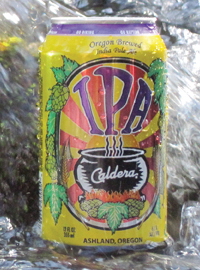Beer sellers: Beermongers
ABV: 6.1%
Origin: Ashland, Oregon, USA
Website: www.calderabrewing.com

Caldera IPA
Of all the taboos that craft brewers in the United States have systematically busted, the notion of craft beer in a can is arguably one of the most challenging. It certainly was to me. I listened with some incredulity when the charming Garrett Marrero of Hawaii brewery Maui first made the case to me. Surely canning was the ultimate insult, demonstrating the contempt in which the big brewers held the world’s greatest drink, and canned beer the epitome of mass produced industrial fizz?
But beyond the prejudice, canned beer makes sense. Cans offer numerous advantages that big brewers like for perfectly rational reasons – they’re lighter, sturdier, easier to pack and transport than bottles, and even have an environmental justification, particularly in cultures like the US and UK where returnable bottles are seen as a tough ask on customers. Modern can linings no longer taint beer with metallic flavours, and are fine for modern unpasteurised and naturally recarbonated craft beers. The one thing that doesn’t work so well in a can at the moment is refermentation, though some brewers are experimenting with “can conditioned” beers.
Cans were just as taboo among beer connoisseurs in the US as in Britain, but Caldera, alongside Maui, 21st Amendment, Oskar Blues and a few others, is now challenging that. Founded in the southern Oregon city of Ashland, not far from the California state line, in 1997, it originally produced only draught beer, and its IPA was one of its first recipes. When it decided to move into packaged beer in 2005, it settled on cans as the ideal vessel, the first Oregon micro to do so.
The IPA stands up very well to the process. This is very much a hop-led West Coast example of the style, dosed with Simcoe, Centennial and Amarillo to a hefty 94 IBU, but on a firm malt base that adds some Munich and Crystal to the two-row US pale malt that provides the backbone.
I enjoyed one of these colourful cans with lunch at a deli in central Portland, Oregon, whereThey’re relatively easy to come by. It was especially delightful to enjoy unusual quality beer in an otherwise perfectly everyday eating place – Portlanders take it for granted.
This amber beer turned out lightly hazy, with a thick, rocky slightly pinkish head. A relatively gentle whiff of pine and fennel set up a smooth palate with plenty of firm toffeeish malt well integrated with smooth, earthy, piny, peppery hops – considerably less overbearing than expected given the IBU. The hops clung on the swallow, but didn’t disrupt the smoothness of the finish, which remained approachable despite the vivid, drying bitter spicy notes.
I admit – I never expected to taste such a fine brew from a can.





Leave a Reply